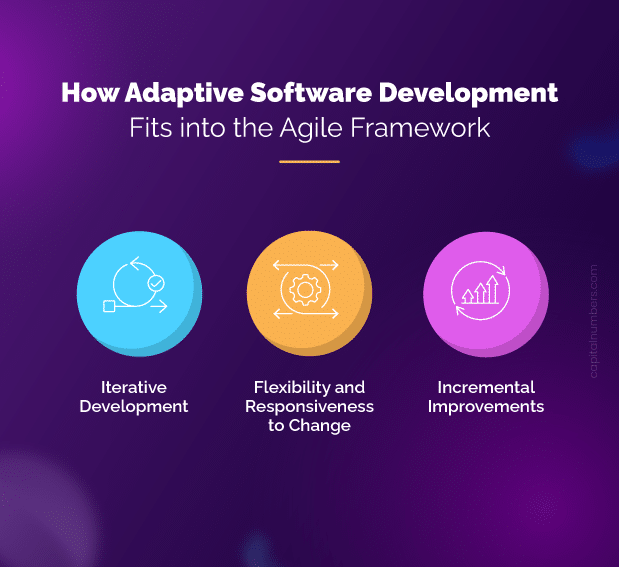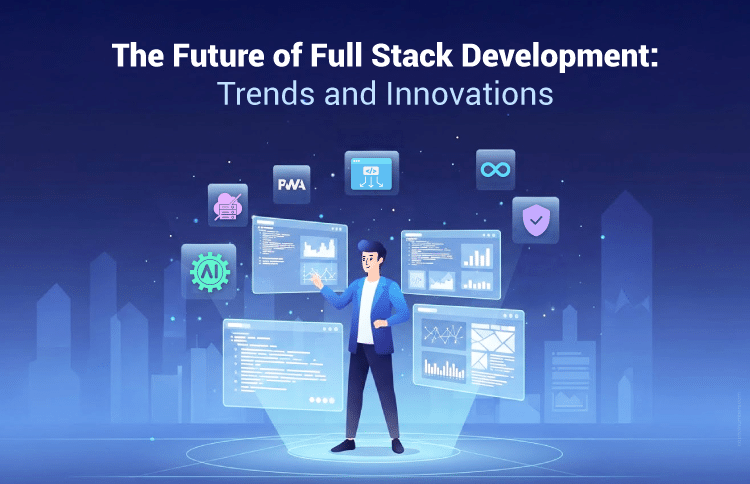Adaptive Software Development: The Agile Approach for Modern Projects
Table of Contents
Adaptive Software Development (ASD) is a dynamic approach to custom software development. Unlike traditional methods, ASD emphasizes flexibility and rapid responses to change, making it highly effective for modern software projects.
This blog explores the characteristics, pros, and cons of ASD and provides practical insights and best practices to help software developers implement ASD effectively in their projects.
What is Adaptive Software Development?
Adaptive Software Development (ASD) is a method for building software that prioritizes flexibility and responsiveness to change. It emerged in the mid-1990s as a response to the limitations of traditional, rigid development methodologies like Waterfall. ASD focuses on iterative development, where software is built and improved through repeated cycles.
Origins of ASD
ASD was created by Jim Highsmith and Sam Bayer. They saw the need for a more flexible approach that could handle the fast pace of technological change and unpredictable project requirements. Their goal was to develop a method emphasizing collaboration and learning throughout development.
Core Principles of ASD
- Collaboration: ASD promotes strong teamwork and open communication among all project stakeholders, including developers, clients, and end-users. This ensures that everyone is aligned and working towards common goals.
- Learning Cycles: ASD emphasizes short development cycles (iterations) that allow teams to learn and adapt quickly. Each cycle includes planning, building, and reviewing, leading to continuous improvement.
Struggling to find the right software for your business?
Opt for custom software development services from Capital Numbers to get feature-rich, scalable solutions that perfectly match your business needs!
What Are the Characteristics of the ASD Process?
The adaptive software development process focuses on flexibility, collaboration, and continuous improvement. Here are the core principles of the adaptive software development process that distinguish it from traditional models:
- Iterative Approach:
Work is done in cycles, with each iteration improving the software. - Flexibility:
Changes are welcomed throughout the development process, ensuring the software evolves as needed. - Collaboration:
Strong communication and teamwork between developers, stakeholders, and clients. - Rapid Prototyping:
Quickly build and test prototypes to gather feedback and refine the product. - Focus on Client Needs:
Regular feedback from clients ensures the software meets their needs. - Risk Management:
Early identification and management of risks can help avoid major issues later. - Continuous Improvement:
Constant evaluation and enhancement of both the software and the development process itself.
The Agile Approach in ASD
Agile methodologies are popular ways to manage software projects by focusing on flexibility, collaboration, and customer feedback. Common Agile methods include Scrum, Kanban, and Extreme Programming (XP).
- Scrum: Uses fixed-length iterations called sprints, usually 2-4 weeks long. It emphasizes roles (Scrum Master, Product Owner, Development Team), daily stand-up meetings, and regular sprint reviews.
- Kanban: Focuses on visualizing the workflow with a Kanban board. It manages work in progress (WIP) limits to improve efficiency and reduce bottlenecks.
- Extreme Programming (XP): Emphasizes technical excellence and good practices like pair programming, test-driven development (TDD), and continuous integration.
Agile Methods vs. Adaptive Software Development
While Scrum, Kanban, and XP each have their own unique practices, they all share core Agile values of flexibility, collaboration, and continuous improvement. ASD aligns with these values but focuses even more on adaptability and iterative learning.
How ASD Fits into the Agile Framework

ASD fits perfectly into the Agile framework by emphasizing:
- Iterative Development: Similar to Agile, ASD uses short development cycles called iterations. Each iteration involves planning, coding, and reviewing, allowing teams to make continuous improvements.
- Incremental Improvements: ASD encourages making small, manageable changes regularly, rather than big, infrequent updates. This helps teams adapt quickly and keep up with changing requirements.
- Flexibility and Responsiveness to Change: Like other Agile methodologies, ASD is built to handle change. It allows teams to adjust their plans and priorities based on new information or feedback, ensuring that the final product meets user needs.
In essence, ASD is a highly adaptive form of Agile that helps developers stay flexible and responsive throughout the software development lifecycle.
You May Also Read: Agile Strategies for Fixed-Cost Web Development Projects
What Are the Phases of the ASD Process?
Speculate Phase
The Speculate Phase is where the initial planning happens. Think of it as the blueprint stage for your project. Here, the team envisions what the final product should look like and how to get there. This phase involves setting clear goals and expectations. The team discusses what they want to achieve and outlines the steps needed to reach these objectives. It’s like creating a roadmap for the project, but with the understanding that changes might be needed along the way.
Collaborate Phase
The Collaborate Phase is all about teamwork and communication. In this stage, developers work closely together, ensuring that everyone is on the same page. Regular meetings and open communication channels are crucial. This phase also involves stakeholders—clients, end-users, and anyone with an interest in the project. Their feedback and input are vital for guiding the development process. The idea is to create a collaborative environment where ideas flow freely, and everyone works towards a common goal.
Learn Phase
The Learn Phase is where the team focuses on continuous improvement. After each iteration, feedback is gathered and analyzed. This creates a feedback loop where the team learns from each cycle and makes necessary adjustments. It’s an iterative process, meaning the team goes through multiple cycles of development, learning, and improvement. This phase ensures that the project evolves and adapts to new information, leading to a better final product. Continuous learning and adapting are key to ASD’s success.
Strengths of the Adaptive Software Development Model
- Flexibility:
The adaptive software development model allows teams to easily adjust to changing requirements, making it ideal for projects where client needs may evolve over time. - Faster Delivery:
By working in short, iterative cycles, developers can deliver parts of the software sooner, providing value to clients at an early stage. - Client Involvement:
Regular feedback from clients throughout the development process ensures the product is consistently aligned with their expectations and requirements. - Risk Reduction:
Frequent assessments and early detection of issues help reduce the chances of facing major problems later in the project, ensuring smoother progress. - Improved Collaboration:
The process promotes constant communication between developers, clients, and other stakeholders, fostering a collaborative environment that enhances understanding and results. - Continuous Improvement:
Each iteration provides an opportunity to refine the software, ensuring that the product improves over time and meets higher quality standards.
Weaknesses of the Adaptive Software Development Model
- Uncertainty in Planning:
The flexibility of the adaptive software development model makes it hard to predict exact timelines and costs at the beginning of a project. - Resource Intensive:
The need for frequent iterations and ongoing client involvement can require more time and resources, increasing project costs. - High Client Availability:
This model depends on regular feedback from clients, which may be difficult if they are not consistently available or engaged. - Scope Creep:
The flexibility to change requirements can lead to scope creep, where the project expands beyond the original plan, causing delays and added complexity. - Team Experience:
The model works best with experienced teams. Less experienced developers may find it harder to manage the iterative process effectively. - Challenges with Large Projects:
For larger projects, managing iterations and coordinating teams can become more difficult, leading to confusion or missed requirements.
Key Differences Between ASD and Traditional Methodologies
There are a lot of differences between traditional methodologies and the Adaptive software development model. Check the table for a better understanding:
| Aspect | Adaptive Software Development (ASD) | Traditional Methodologies |
|---|---|---|
| Flexibility | Highly flexible, allowing changes and adjustments throughout the development process. | Less flexible, with changes being costly and difficult to implement once the project starts. |
| Project Phases | Iterative process with short cycles (iterations) where each phase overlaps. | Sequential process (Waterfall) with distinct, non-overlapping phases. |
| Client Involvement | Continuous client feedback and involvement throughout the development process. | Limited client involvement, often only at the beginning and end of the project. |
| Risk Management | Risks are identified early and addressed in each iteration, reducing major issues. | Risks are often addressed after the planning phase, making it harder to adapt. |
| Delivery | Delivers working software in stages, providing value early and often. | Delivers the complete product at the end, after all development work is done. |
| Scope Changes | Easily accommodates changes in scope and requirements during the project. | Changes in scope can be difficult and costly to implement once the project is underway. |
| Planning | Less emphasis on detailed upfront planning; focuses on continuous refinement. | Heavy emphasis on detailed upfront planning before the project begins. |
| Project Size | Works well for both small and large projects, but can be more complex to manage as the size grows. | Suited for larger projects with well-defined requirements and scope. |
| Team Collaboration | Strong emphasis on collaboration and communication between all team members and clients. | Less frequent collaboration between developers and clients, with teams working in silos. |
Traditional methodologies like Waterfall follow a linear, sequential process, where each phase (requirements, design, implementation, verification, and maintenance) is completed before moving to the next. In contrast, ASD is iterative and cyclical. It embraces change at any stage of the software development project, allowing for more frequent adjustments based on feedback and new information.
Implementing ASD in Modern Projects
To start using Adaptive Software Development (ASD) in your software development projects, you need to transition from traditional methods. Here are the steps:
- Assess Your Current Process: Identify what works and what doesn’t in your current methodology.
- Educate Your Team: Provide training on ASD principles and practices. Understanding the core concepts of ASD is crucial.
- Start Small: Begin with a pilot project to test the new approach. This helps the team get comfortable with ASD without the pressure of a major project.
- Iterate and Improve: Use feedback from the pilot project to refine your process.
Training and Skill Development
Training is essential for a smooth transition. Invest in workshops, courses, and seminars to help your team understand ASD. Encourage continuous learning and skill development to keep up with best practices and new tools.
Best Practices for Effective ASD Implementation
- Setting Up Cross-Functional Teams: Create teams that include members with diverse skills. A cross-functional team can handle different aspects of development, from coding to testing, ensuring a holistic approach to problem-solving.
- Utilizing Appropriate Tools and Technologies: Use tools that support collaboration and continuous integration.
- Establishing Clear Communication Channels: Open and transparent communication is vital. Regular stand-up meetings and reviews ensure everyone is on the same page and can address issues promptly.
Tools and Technologies Supporting ASD
Project Management Tools
Project management tools are essential for tracking progress and managing tasks in Adaptive Software Development (ASD). Here are some popular options:
- Jira: A powerful tool used for tracking issues, bugs, and project progress. Jira allows you to create user stories, plan sprints, and generate reports, making it ideal for Agile and ASD practices.
- Trello: A flexible, visual tool that uses boards, lists, and cards to organize tasks. Trello is great for smaller teams or simpler projects, providing an easy way to manage work and track progress.
- Asana: A comprehensive tool for managing projects, tasks, and deadlines. Asana supports task assignments, timelines, and project tracking, helping teams stay organized and on schedule.
You May Also Read: Top 10 Must-Have Software Development Tools for Tech Companies
Collaboration and Communication Tools
Effective communication and collaboration are crucial in ASD. These tools facilitate real-time interaction and coordination:
- Slack: A popular messaging platform that enables team communication through channels, direct messages, and file sharing. Slack integrates with many other tools, enhancing team collaboration.
- Microsoft Teams: A robust platform for chat, video meetings, and file collaboration. Teams integrates seamlessly with Microsoft Office products, making it a versatile choice for many organizations.
- Zoom: A video conferencing tool that supports virtual meetings, webinars, and screen sharing. Zoom is useful for remote teams needing reliable, high-quality video communication.
Continuous Integration and Deployment (CI/CD) Tools
CI/CD tools automate the integration and deployment of code, ensuring faster and more reliable releases:
- Jenkins: An open-source automation server that supports building, testing, and deploying code. Jenkins is highly customizable and integrates with many other development tools.
- GitLab CI: A built-in continuous integration and deployment tool within GitLab. It allows you to define pipelines for automated testing and deployment, streamlining the development process.
- CircleCI: A CI/CD platform that automates the building, testing, and deployment of code. CircleCI is known for its speed and scalability, making it suitable for projects of all sizes.
Future of Adaptive Software Development
Emerging Trends
Adaptive Software Development (ASD) is constantly evolving, and several emerging trends are shaping its future:
- Integration with AI and Machine Learning: As artificial intelligence (AI) and machine learning (ML) technologies advance, they are becoming integrated into ASD. AI is transforming the software development process by automating repetitive tasks, predicting project risks, and improving decision-making through the analysis of data patterns. Machine learning algorithms can enhance software testing and quality assurance by identifying potential issues faster than traditional methods.
- Evolution of DevOps in Conjunction with ASD: DevOps, which combines development and operations, is evolving alongside ASD. The integration of DevOps practices with ASD promotes continuous delivery and integration, ensuring faster and more reliable software releases. This combination improves collaboration between development and operations teams, leading to more efficient workflows and better product quality.
Predictions and Innovations
The future of ASD holds exciting possibilities and innovations:
- How ASD Will Shape the Future of Software Development: ASD’s emphasis on flexibility and adaptability will continue to influence software development practices. As businesses increasingly require rapid responses to changing market conditions, ASD will become even more critical. It will drive the adoption of iterative and customer-focused approaches across the industry.
- Potential Advancements and New Methodologies: New tools and technologies will emerge to support ASD. For example, advanced analytics and real-time feedback systems will provide deeper insights into project performance. Additionally, methodologies that blend elements of ASD, AI, ML, and DevOps will likely develop, creating more robust and adaptive frameworks for software development.
You May Also Read: Offshore Software Development in 2025: Myths vs. Facts
Conclusion
Adaptive Software Development (ASD) is essential for modern projects due to its flexibility, strong collaboration, and continuous improvement. It helps teams adapt quickly to changes, improve communication, and deliver high-quality software efficiently.
Adopting ASD can enhance development processes and meet evolving project needs. Its focus on iterative learning and adaptability makes it a valuable approach in today’s fast-paced tech environment.
Want to enhance your project’s success with ASD? Contact us today to get started!


 Web Development
Web Development Cloud Engineering
Cloud Engineering Mobile App Development
Mobile App Development AI/ML/GenAI
AI/ML/GenAI E-commerce
E-commerce Software Development
Software Development UI/UX
UI/UX QA
QA Dedicated Teams
Dedicated Teams












